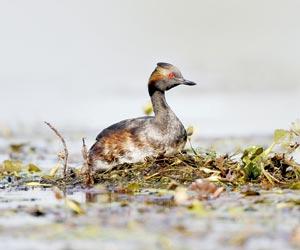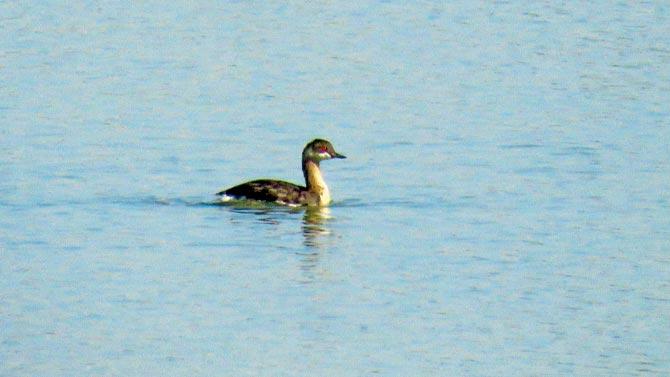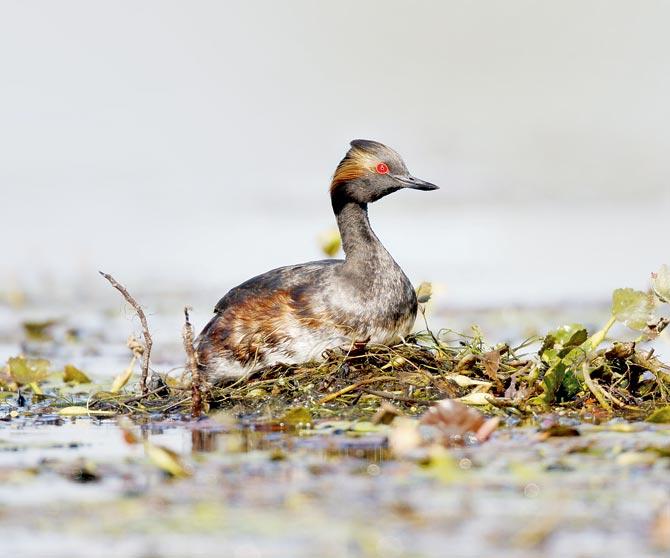In a first, coral red-eyed migratory bird travels around 5,000 km in search of new habitat in the city

Even as bird watchers rue the dwindling population of the migratory pink flamingoes in the concrete jungle that Mumbai is, a rare sighting of the Black-Necked Grebe earlier this week – believed to be its first sighting in Mumbai – has fuelled new hope among wildlife lovers. The coral red-eyed migratory bird, which is otherwise only seen in the North Western parts of India during winter, was spotted in a salt-water lake near Bhandup Pumping Station, along the Eastern Express Highway on Tuesday.
ADVERTISEMENT
 The Black-Necked Grebe spotted at Bhandup
The Black-Necked Grebe spotted at Bhandup
The bird-watching group that spotted the pigeon-sized bird took a video of it swimming in the lake. The video was later posted on Facebook, after which many bird lovers made a dash for the area and were lucky enough to spot it on Wednesday too.
Bird comes to city
Bird watcher and naturalist Akshay Shinde was among the many, who got to see the bird again on Wednesday afternoon. "A notification on Facebook about the sighting of the Black-Necked Grebe in the city aroused my curiosity," said Shinde, who has been involved in birding activity for nearly five years. After researching on it, he reached out to local bird expert Vikrant Chaurasiya, who was part of the team that initially spotted it.
Experts working in the field of birding have confirmed that the sighting of the bird is the first from Mumbai. Birding expert Adesh Shivkar said, "This is the first record of the Black-Necked Grebe from Mumbai. These birds are originally from Central Asia and during winter, they migrate to some parts of India. But, there have been no records of it in Mumbai."
 Akshay Shinde
Akshay Shinde
According to Shivkar, the bird could have made a pit stop in the city, in search for a new habitat. "Over the years, there has been a decrease in the habitat of birds because of rampant development. When the areas where these birds come during migration get destroyed, the birds search for newer habitats. This might have been one of the reasons why the bird was spotted at Bhandup pumping station," said Shivkar.
The rise in birding networks on social media has also helped identify new sightings of birds, if any. "Earlier, bird lovers wouldn’t publish their documented evidence on social media, but now, everyone is in the know of new sightings," added Shivkar.
Unfortunately, this also puts the birds at a disadvantage, said Shinde. "Many people will want to go and take photos of the bird in Bhandup, which could put it at risk," he said.

Representational Pic
Rare winter visitor
The bird has previously been spotted in Ladakh and New Delhi during the winter season. Since the bird is known to thrive in brackish water, its sightings have also been recorded in salt-pan areas near Jamnagar.
The bird is said to travel around 5,000-6,000 km during migration. While insects caught either on the surface of the water or when they are in flight, make up for majority of its diet, it occasionally eats tadpoles, small frogs and fish through foliage gleaning -- picking up invertebrate from the trees, surface of ground or rock.
According to International Union for Conservation of Nature, this species is found on every continent except Australia and Antarctica. It is most commonly seen in Western Europe and Central Asia, and is found wintering in East Asia, Southern Africa.
 Subscribe today by clicking the link and stay updated with the latest news!" Click here!
Subscribe today by clicking the link and stay updated with the latest news!" Click here!






